 |
Photoponics
- Research & Development |
| |
|
|
Welcome to the
page where things that we think need to be mentioned
or referenced, are.


become PURple
All following
text content is based on my opinions and I invite all
to criticize, but please by email first. -
Clive Wing in 2004
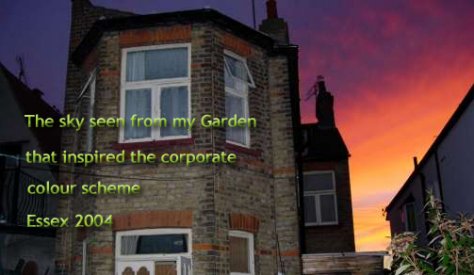 |
|
| |
Clive & Tom Wing 2007 |
| |
|
Photoponics
means "light works" - For me, so it's just
my current opinon, before there was mass or energy there
was light. Light is both a "mass" (particle)
and "energy" (waveform). So perhaps all mass
and energy was once light and that's why I am facinated
by the stuff, the way it creates life and all our realities.
When all else fails I suggest watching Monty
Python or taking a walk in the woodlands.
(Songs below can take a while to downlad but
it worth it)
The first music
I ever purchased myself wasa new single Rolf Harris
- Two Little Boys in 1969, and also a second hand album
Deep Purple - Shades of Purple, my whole life changed
when I listened to Mandrake
Root
What I dont like: Insects, dangerous & deadly creatures
& dangerous sunlight.
The Australian Prime Minister, John Howard was in England
meeting the Queen at Balmoral. They were discussing
Australia and Howard's plans for the future. Howard
asked the queen if it was possible to turn Australia
into a Kingdom to increase its force in the world market.
The Queen replied, "One needs a King for a Kingdom
and you are most certainly not a King." He then
asks if it is possible to turn Australia into an Empire.
The Queen replies, "For an Empire one needs an
Emperor you are most certainly not an Emperor."
Howard thinks for a moment and then asks if it is possible
to turn Australia into a principality. The Queen replies,
"For a principality one needs a Prince and you
Mr. Howard are certainly not a prince." The Queen
adds further, "Without meaning to be rude Mr. Howard
I think Australia should remain as a country."
Me &
My Plasma - our first shagtastical day together in the
mini - The Movie 23Mb

Warning - I was so happy I started singing
|
|
started
by Clive Wing in 2004
|
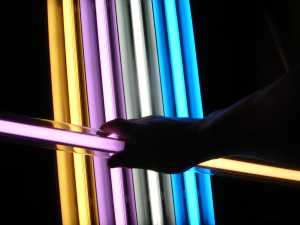 |
|
3-Dimensional
Lighting for plants - The nurturelite
Sabre is pioneering the next generation
of fluorescent light application. Finally,
the place for fluorescent lighting to be
most effective for plants can be reached.
Now you can safely hang the power of PURple
right in amongst your plants and pets. The
photoponic effect exceeds all other lighting
for plants we have ever tried and we are
very excited about our initial results.
The unique poly carbonate sabre sheaf distributes
the heat for safe operation, surface temperature
is below 25C, plants can grow round and
up the sabre using it as support. |
|
|
Essex,
England first in world to pioneer phototherapy
for newborns (nothing to do with 460nm effect on circadian
cycles).
  

 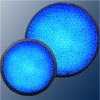 
LEDs
from
nurturelites
are being developed for humans before plants.

Germany first in world to have 300w CFL
World's first air-cooled
10U lamp
nurturelites
are now making the worlds first air cooled
self-ballasted T5HO lamp. Fitted with
thermostatically controlled internal fans,
this is the ultimate T5HO lamp. When the
going gets hot (>35C), the nurturelite air-cooled
range cools things down.
|
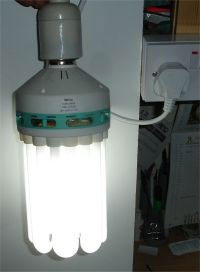
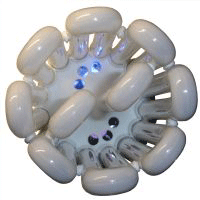  |
Significance
of Ambient Temperatures - T5HO
lamps produce their maximum light output
at 35C or 97F, while T8 lamps give their
maximum light output at 25C or 78F (T5
max lumen is about 30C). Both lamp types
have bell shaped lumen output curves
that slope off quickly on either side
of their optimum temperature. A difference
of 20C either way from optimum working
temperature will decrease lumen output
of all fluorescent lamps, regardless
of type or brand, by 20% or more. T5HO
lamps will perform better in non-conditioned
warehouse spaces since heat accumulates
at warehouse ceilings and temperatures
are often 15-20F higher than at floor
level. T8 lamps will perform better
in air conditioned spaces or cooler
conditions. T5HO fixtures (like our
dome reflector and nova) can be equipped
with sealed lenses for use in refrigerated
storage areas and zero temp storage
areas. It should be noted that both
T5HO and Hi-Lumen T8 fixtures generate
a great deal of heat, so selecting a
properly designed, well ventilated fixture
is very important. Poorly designed fixtures
will retain heat that will significantly
shorten ballast life and decrease lamp
lumen output. When high ambient temperatures
are expected on a routine basis, a T5HO
ballast with a 90C or 194F case temperature
rating should be specified, rather than
the standard 70C or 158F case temperature
rated products used for T8 and T5.
The
PhotoCat (Photocatalytic Air
Cleaner) was developed in our UK labs
for air cleaning and cooling methods,
by creating a photo-plasma from the
specially adapted CFL 200w lamp. When
used internally the nurturelite PhotoCat
(Photocatalytic Air Cleaner)
can reduce waste organisms
in the air of a hospital room with an
area of 144-180 square feet and a height
of 2.8 meters to under 3ppm (parts per
million) in 30 minutes. Perfect for
cleaning air, removal of all odors and
bacteria before exhausting to another
room "clean" and perfect for humans
and animals.
|
nurturelites
PhotoCats are more efficient than activated-carbon
air cleaners or "scrubbers" For plants
the nurturelite PhotoCat system should be used to exhaust
from a grow area. Beware that cleaning the air
with a PhotoCat or any scrubber can remove many
of the essential nutrients a plant needs in the
air.
Watt
for Watt - what watts are the
ones I pay for?
In practice, it is the energy used for environmental
control that can be reduced when using Energy
Saving Lamps, this is reality, there is no need
for the false claims of incredible savings some
might make, the truth is easily good enough.
Compare actual
power usage of both ballast and lamp and watt
for watt comparison can make most people think
about electricity costs properly for the first
time.
nurturelite 600w HPS Lamp + 600w ballast = 635w actual
system power usage
nurturelite 200w T5HO Lamp + 200w ballast = 161w actual
system power usage
Thus, watt for watt, 600w HPS is roughly equivalent
to 800w (4x200w) T5HO. We see comparison between
HPS and T5HO as a similar comparison between Hydro
and Terra. The first will probably give you higher
quantity, the latter will give you better quality.
So, the word "equivalent" is used by us in the
context of quality and quantity balancing each
other. A synergy of both technologies is the nurturelite
suggested way forward.
No doubt this is another
debate riddled with incredible claims, but often
common sense is all you need. We try to emulate
nature to nurture well, often that which looks
most like nature is the best for use to nurture.
200w
Self-ballast 6U or 8U or 10U ?
We've tried and tested every type of CFL
shape available and have confirmed that
6U is the most superior of all shapes for
horizontal application. If the lamp is mounted
vertically, may be using an umbrella shaped
reflector, the 10U is easily most superior.
This is why we are now using the 6U, for
superior photoponics, with any conventional
horticultural reflector (horizontal mount)
on all 200w lamps.
In 2004 we were using the 8U, but we continued
to suffer many breakages during delivery.
So now we have developed the 10U 300w nurturelite
for those that want strong vertical lamps
and/or a lot more than 200w in one T5 lamp.
(Please note 300w currently available only
in Germany DE).
Mini
HQ Reflector - British/Chinese
Design, German reflective materials. Easily
strong enough to hold the nurturelite 300w and
heavy 200w of the poorest quality (Envirolite)
self-ballast completely horizontal.---------
(Pictured example has one wing removed) |
300w
(10U) nurturelite
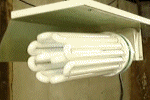 |
| Identify
Soft-Start,
distinctive "phased" and increasing 3
steps, so only 95w, for example,
initial power, less aggressive
to circuitry, thus increasing
life span of whole lighting system.
nurturelite for the highest quality.
|
Poor
Quality Envirolite  |
|
| Please
note, the 172w lamp is an original Chinese
model, made in same factory as the others.
It is not a German branded copy, it is
not made in Germany and never has been.
Lamps and ballasts
have different ratings and the only true
measurement of power consumption is the
the combined lamp and ballast wattage.
The 3 lamps on
the left are self ballasted, these use
poor Power Factor (PF) ballasts of between
PF 0.6 and PF 0.7, using more power does
not necessarily mean more light.
The 3 lamps on
the right are separate ballasted these
use high power factor PF 0.98 to PF 0.99
separate ballasts. |
| Compare
front left self-ballasted with front right
separate ballasted, it's physically exactly
the same glass lamp, but the high PF separate
ballast means less power, lower running
costs, but more light! Please note that
the source of data used and displayed is
from tests we carried out in a room 4mx4m
with ambient temperature of only 12 degree
centigrade. In normal use all of the lamps
would operate in warmer environment and
Lm/W performance would improve for all of
the lamps. |
75
Lm/W x 150W
=
11,250 Lm
|
85Lm/W
x 142W
=
12,070 Lm
|
|
 Dont bother with the last millenniums technology,
stop using old CFL's
Dont bother with the last millenniums technology,
stop using old CFL's 
Start using T5HO Linear Tubing which is massively
geometrically superior.
|
The
best shape ( for those that prefer horizontal
) is a grill or rack of single tubes,
This is why we have developed the PS1,
Tray, Rack and Wing systems , all using
the T5 (VeryHighOutput) tubes. The 55cm
tubes are easily placed (and replaced)
in ballasted reflector strips. This allows
for extremely efficient use of space in
the growing area, crops can be layered,
with the heat being used to warm roots
of the crops above which could also be
on a different lighting schedule (day
length). It is the Growers and practitioners
that have demanded this shape of lighting
system and no explanation is needed to
see why, if not the best, then it is at
least the most efficient "shape" for using
T5 tubes. |
288w
(550mm)
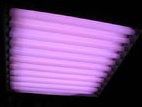
12 x 24 w PURple Photoponic Tray System
(PTS1) |
Fluoro
and HPS (HID) - The Truth
The difference between
Fluorescent and High Intensity Discharge lamps,
and it's significance in the application to plant
growing seems rarely understood and/or explained
honestly.
So, we've tried to do this, nurturelite manufacture
and supply all types of lighting, so we do not
have favorites, in our opinion, all photon generators
(lamps) are are equal & beautiful.
Like people, some light types may be better at
different applications to others.
Fluorescent's create light in a completely different
way to HID's.
You should not expect HID bulbs to emit anywhere
near the QUALITY of light that fluorescent's do,
and
you should not expect fluorescent's to emit anywhere
near the INTENSITY of light HID's do.
If you look at the SPDs' of many HID lamps (sodium
or metal halide), actually they all look very
much the same... in terms of PUR or PAR or proportional
distribution of wavelength energy.
If you look at a SPD of fluorescent lamp, particularly
customized like the nurturelite PURple range, they all
look very different. [more SPDs]
Fluorescents create light
by passing an electrical current through mercury
vapor, producing UV light. The UV causes the phosphor
powder coating on the inside of the tube to fluoresce,
thus emitting light in the visible spectrum. With
different phosphors generating different wavelengths
of light, the colours can be controlled and customized
by varying the combinations of phosphors used.
Because the light is emitted from the phosphors,
which are spread over a large surface area, coating
the entire inside of the lamp, the light is not
intense.
HID's produce light by
passing electrical current through different metal
vapors, NO coating of phosphor in the way , but
only gases which are controllable, safe and reliable
can be used. So, the colours (different wavelengths
of light) are severely constrained by the limited
types of metal vapors that can be used. However,
the radiation that is emitted is very INTENSE
and often includes copious amounts of Infra Red
for you to burn things with, like plant tops.
Now, also consider Infra Red heat is not effected
by convection or conduction cooling technology,
(electric fans and water cooled"cool tubes") it
is radiation, not conduction or convection. This
is why the INTENSITY of the (poor light quality)
HID lamp can be used to cover large areas, if
you bring the lamp too close you will radiate
your plants with horrid IR heat, HID lamps and
all ballasts must be kept a safe distance away
from the plants to avoid IR radiation damage.
| Type
of lighting |
Average
distance between light and plant
tops |
| Fluorescent
- T5HO - any wattage |
3cm
to 10cm |
| HPS
400w |
30cm
to 40cm |
| HPS
600w |
50cm
to 60cm |
| HPS
1000w |
70cm
to 80cm |
|
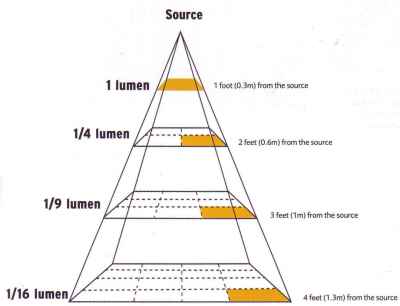 |
Distance:
The quantity of light rapidly diminishes
as the distance increases in relation
to the light source. If the lights are
too far away, the plants will grow tall,
less sturdy and will be less productive.
If the lights are too close, growth is
impede, the plants will wither and dry
and may even be burned if the area is
poorly ventilated.
Reflective Material:
Another topic riddled with fairy tales,
it might help you to know percentage of
reflection for Aluminum foil, white enamel
paint and white plastic is 70 to 80%,
for Matt white paint it is 85 to 90% and
for Mylar it is 90 to 95%. |
Fluorescent lighting needs
more attendance from the grower than HID because
the light needs to be moved up, often on a daily
basis, so that the optimum distance (about 5cm)
can be maintained as the plant grows. Because
most of us have the electricity, space and environmental
equipment needed for the "big rough" HID, that's
what most people use.
Fluorescent lighting appeals to HID users as a
way of supplementing the colours lacking in HID
lighting systems
Strictly nurturelite fluorescent only example: 10 x
200w (2000w) nurturelite PURple red lamps produced same
yield as crop did with 3 x 600w (1800w) HPS, but
the grower reported that although quantity/yield
was fractionally down, the QUALITY was up massively,
because there is so little heat, all of the "qualitative"
characteristics of the plant tops are not "evaporated"
by IR heat. this is especially relevant during
the flowering stage when plant surfaces in the
flower region are particularly photoponically
sensitive and vulnerable to humidity and over-heating
problems.
|
| |
|
Nanometric
Scale - Visible Light Spectrum
The visible light spectrum
is from Violet to Magenta with Green in the middle,
measured in nanometers (nm). Purple is not a single
colour of visible light, it is 2 colours, blue
and red.
|
|
| |
|
Colour
Rendering Index - Not for measuring critical light
for Plants "We
are Ladies" - Little Britain-
BBC 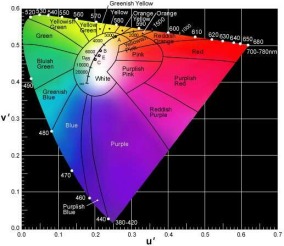
As soon as you see the picture above, know that
it has nothing to do with plants, unless you are
particularly concerned about what humans see,
it is the root of all ignorance and "creative
salesmanship". This chart is frequently used by
those wishing to mislead plant growers into buying
"gay & pretty looks" rather than useful radiation.
CRI rating is important
when checking your clothes, especially separate
tops, trousers or skirts and to ensure that the
colours are not influenced by the light source,
and the general "made-up" opinion of what good
colour is. Anyone who knows their CRI is also
well qualified to distinguish the subtle tonal
differences found in navy blue blouses and dresses.
To help indicate how colors
will appear under different light sources, a system
was devised some years ago that mathematically
compares how a light source shifts the location
of eight specified pastel colors on a version
of the C.I.E. color space as compared to the same
colors lighted by a reference source of the same
Color Temperature. If there is no change in appearance,
the source in question is given a CRI of 100 by
definition. From 2000K to 5000K, the reference
source is the Black Body Radiator and above 5000K,
it is an 'agreed upon' form of daylight.
An incandescent lamp, virtually
by definition, has a Color Rendering Index (CRI)
close to 100. This does not mean that an incandescent
lamp is a perfect color rendering light source.
It is not. It is very weak in blue, as anyone
who has tried to sort out navy blues, royal blues
and black under low levels of incandescent lighting
could tell you. On the other hand, outdoor north
sky daylight at 7500K is weak in red, so it isn't
a "perfect" color rendering source either and
would just ruin subtle contrasts in your Pinks,
that just wont do. Yet, would you believe it,
it also has a CRI of 100 by definition.
CRI is useful in specifying
color if it is used within its limitations. Originally,
CRI was developed to compare continuous spectrum
sources whose CRI's were above 90 because below
90 it is possible to have two sources with the
same CRI, but which render color very differently.
At the same time, the colors lighted by sources
whose CRI's differ by 5 points or more may look
the same. Colors viewed under sources with line
spectra such as mercury, metal halide or high
pressure sodium lamps, may actually look better
than their CRI would indicate. However, some exotic
fluorescent lamp colors may have very high CRI's,
while substantially distorting some particular
object color.
Technically, CRI's can
only be compared for sources that have the same
Color Temperatures. However, as a general rule
"The Higher The Better"; light sources with high
(80-100) CRI's tend to make things look better
to humans than light sources with lower CRI's.
Why still use CRI if it
has so many drawbacks? It's the only internationally
agreed upon color rendering system that provides
some guidance. It will be still be used until
the scientific community can develop a better
system to describe what we really see. It is an
indicator of the relative color rendering ability
of a source and should only be used as such. Plants,
even lady ones, are not concerned with CRI ratings.
|
|
|
| Kelvin
Scale - Not for measuring critical light for Plants
People talking about black
body's and radiators ? What are they talking about?
Usually they don't really know, and even more
worrying , they never explain it properly.
Based upon the definitions of the Centigrade
scale and the experimental evidence that absolute
zero is -273.15°C, thus 373.15K is the same as
100°C. The Colour Temperature represents
the colour that Carbon is when heated to that
temperature. So when carbon is heated
to 2000K it looks "red" hot. Carbon does not look
green at any temperature, if it did, it's what
we would call "white Hot". So remembering that
Kelvin is used to measure an 'overall' colour,
it's ok as a guide only, to differentiate between
PURple and Green, Kelvin is useless.
|
|
|
Even the Diamond &
Gemstone industry has "seen the light" when it
comes to Kelvin [more]
|
| LUX
Meters - Not for measuring critical light for Plants
In 1924, the Commission
de l'Eclairage (CIE) created a standard photopic
luminosity function or 'standard observer' for
photometric measurements. For the human eye, an
efficiency of 1 was assigned to the wavelength
of 555 nanometers (nm). The logarithm of this
function is the 'relative visual brightness'.
Nothing to do with plants, all to do with the
response of the human eye.
All LUX meters are biased,
measuring power and lumens based on the phototropic
curve. On the PURple chart below you can see the
large phototropic curve (the green line) peaking
at around 550nm. So when you put a lux meter under
a green light (white & bright looking to humans)
you get a massive reading on your LUX meter. The
less well informed assume that lots of lumens
here are good, and over look the fact that all
plants reflect at least 50% of this away, which
is why plants look green.
Now if you put the same
LUX meter under a blue or red light, which is
the same power e.g. 200w, instead of 20,000 Lumens
you will measure 10,000 Lumens. The red or blue
light will actually look dimmer to you, because
you are a human. But in reality, the red and blue
light is most useful to plants, so the lumens
rating is useless for measuring useful plant light.
Micro-Einstein's are a better way to measure useful
light but even these measuring instruments suffer
from (more linear) biasing [more]. We recommend 300 to 500 microeinsteins/square
meter/second (umol/m2/s) for growing plants.
Illuminance: the luminous
power incident per unit area of a surface. One
lumen per square meter is one lux. One lumen per
square foot is one foot-candle.
Lux: an illuminance equal
to one lumen per square meter.
Lumen: by definition there
are 683 lumens per watt of radiant power at a
wavelength of 555 nm (wavelength for green light).
Lumens are for humans to
judge and measure the brightness of mainly green
light (that looks bright white to humans), which
is also the the colour that plants reject the
most, that's why chlorophyll is green.
|
|
Purple
Green (~550nm)
for humans and plants like it blue (~450nm)
and red (~660nm), with a bit of yellow
to make chlorophyll. Always more than
50% of greenish light is reflected from
plants and not useful.
Green Lumens are for
humans, PURple is for plants [more
SPDs] |
 |
|
plant growth | PURple | human Sensitive |
|

The nurturelite PURple chart |
|
| The
Photosynthesis Action Spectrum is commonly accepted
to be between 350 to 700 nm, thus most fluorescent
lights made for domestic use emit near 100% PAR
(Photosynthetically Active Radiation). Study of
Photosynthetically Useful Radiation (PUR) created
an evolution in nurturing light technology, applying
absorption theory and combining unique techniques
for preparing phosphors, the PURple nurturelite. PURple
is generally accepted by the experienced as “the
best" fluorescent plant light. nurturelites emit most
of their light in the wavelengths that are more
efficient for photosynthesis, namely the red and
blue ends of the visible spectrum. As expected,
because we all really like green, these light
sources can look dim to the human eye and consequently
have poor lumen ratings. Also, their colour temperature
(K) and CRI ratings have little, if any, meaning
[more].
PURple nurturelites were not designed to be "seen" by
humans, but to efficiently stimulate plants with
Photosynthetically Useful Radiation (PUR).
"why the green spike?"
- Phosphor/metal prices in China are 3x more for
red than blue and cost of production would increase
to reduce the green spike. Also, without the green
spike, the light would "look" so "dim" to humans
they would not want to buy it. So, the green spike
is to keep the costs competitive and make it look
bright to humans.
More Reading:
Why is everything going PURple? Why Trees
are Green
PUR ? What a lot of FA PAR ! (Fraction of
Absorbed Photosynthetically Active Radiation).
Estimating PUR requires knowledge of the
spectrum of light and the absorption spectrum
Absorption spectrum of plants
Photoponics - SULPHUR PLASMA 1000w compared with 6 x
400w (2400w) of METAL HALIDE
3M Light Tubes - SULPHUR PLASMA
advanced light source project 94 - SULPHUR
PLASMA
Learn all about Artificial Lighting On-Line
- see chapter 3
Osram Sylvania SPD's
Nutrients in the
Air only 5% in the ground, how did you think they
got there in the ground, huh?:
We have not added the flowers
so that you work with light for this information.
We continue to argue that Sun, Sky and some Rain
is really all any plant needs to grow and grow
good. We all need soil or earth (or some sort
of medium) simply so that we can stand up! Living
with gravity is something we all have to do.
nurturelite products are all
about light and air - the atmosphere. Photoponics
is a science yet to be rediscovered by mankind,
for surely the question should always be "HOW....?"
and not "WHY....?"? For we know how
the sky is blue, don't we? Because 3ft of water
will filter nearly all colours from sunlight except
460nm blue. Which is also the wavelength for circadian
cycles and most light therapy for all forms of
life on this planet. Could be a clue for 'why'
we are spending all our hard earnt money on research
into light and air. Indeed, research off the planet
has shown that plants do not require any soil
providing the atmosphere around the plant, roots'n
all is the right mix and temperature. Our advice
is simple, when growing plants always remember
the 2 most important factors:
95%
or more of any plants nutrients come from the
atmosphere and 5% or less come from the soil.
Photosynthesis means "making
things with light".
Any tree is a good example
of a plant that has taken nearly all of it's nutrients
out of the atmosphere, not the soil under it.
Especially when you consider it's been standing
in the same soil in the same place for the last
50 years!
A rainforest is almost
self-sufficient in nutrients because trees extract
most of the useful nutrients from leaves before
dropping them, and even then what remains of the
leaf falls to the forest floor and decomposes.
When a forest fire occurs
up to 91% of of the entire burnt forest's nutrients
are retained by the atmosphere. They travel with
the wind & rain to new destinations, all over
the world, including your garden.
Phytoplankton produce about
50 per cent of the atmosphere’s oxygen and
take up about 25 per cent of its carbon dioxide.
That was Phytoplankton, not trees, please consider
this while you can still breathe, its little photon
harvesters in the water that keeps us all alive..
Everything moves around
this planet using the atmosphere, generally speaking,
when it's in the soil it has stopped moving, it
won't find the plant and to be of any use to the
plant, the plant has to spend energy to find it
first.
Even soil gets it's nutrients
from the atmosphere!
Sixteen chemical elements
are known to be important to a plant's growth
and survival. The sixteen chemical elements are
divided into two main groups: non-mineral and
mineral. All can be taken from the atmosphere,
however, mankind is not proving to be so 'clever'
in that department of thought, so its perhaps
best to consider foliar application or adding
nutrients during watering. Sometimes its difficult
to know until its too late if the atmosphere needs
changing.
Non-Mineral Nutrients
The Non-Mineral Nutrients are hydrogen (H), oxygen
(O), & carbon (C).
These nutrients are found in the air and water.
Add carbon dioxide (CO2
- carbon and oxygen) and (H2O- hydrogen and oxygen)
to the plant's atmosphere and most expensive nutrient/fertilizers
become virtually redundant. But only a lighting
manufacturer would say that?
In a process called photosynthesis,
plants use energy from the sun to change carbon
dioxide and water into starches and sugars. These
starches and sugars are the plant's food.
Photosynthesis
means "making things with light".
Mankind must look again to the atmosphere, consider
light pollution, and if artificial light has to
be used, then use more nurturing light. Since
plants get carbon, hydrogen, and oxygen from the
air and water, there is little else farmers and
gardeners can do to control how much of these
nutrients a plant can use. See the light.
Mineral Nutrients
The 13 mineral nutrients, which can come from
the soil, are dissolved in water and absorbed
through a plant's roots. There are not always
enough of these nutrients in the soil for a plant
to grow healthy. This is why many farmers and
gardeners use fertilizers to add the nutrients
to the soil.
The mineral nutrients are
divided into two groups:
macronutrients and micronutrients.
Macronutrients
Macronutrients can be broken
into two more groups:
primary and secondary nutrients.
N-P-K The primary nutrients
are nitrogen (N), phosphorus (P), and potassium
(K). These major nutrients usually are lacking
from the soil first because plants use large amounts
for their growth and survival.
Ca-Mg-S The secondary nutrients
are calcium (Ca), magnesium (Mg), and sulphur
(S). There are usually enough of these nutrients
in the atmosphere so fertilization is not always
needed. Also, large amounts of Calcium and Magnesium
are added when lime is applied to acidic soils.
Sulphur is usually found in sufficient amounts
from the slow decomposition of soil organic matter,
an important reason for not throwing out grass
clippings and leaves.
Micronutrients
(Trace Elements)
Micronutrients are those
elements essential for plant growth which are
needed in only very small (micro) quantities .
These elements are sometimes called minor elements
or trace elements, but use of the term micronutrient
is encouraged by the American Society of Agronomy
and the Soil Science Society of America. As most
of this page was based on their writings, it seems
fair and correct to use their preferred terminology.
The micronutrients are boron (B), copper (Cu),
iron (Fe), chloride (Cl), manganese (Mn), molybdenum
(Mo) and zinc (Zn). Recycling organic matter such
as grass clippings and tree leaves is an excellent
way of providing micronutrients (as well as macronutrients)
to growing plants. The Comfrey plant is used in
England for its ability to extract N-P-K from
the soil with deep roots and fill its leaves with
all of the the most powerful ingredients needed
to make a truly organic fertilizer just add water
and air !
Soil
In general, most plants grow by absorbing nutrients
from the atmosphere and supplement deficiencies
in the atmosphere with nutrients from the soil.
Their ability to do this depends on the nature
of the soil. Depending on its location, a soil
contains some combination of sand, silt, clay,
and organic matter. The makeup of a soil (soil
texture) and its acidity (pH) determine the extent
to which nutrients are available to plants.
Soil Texture (the amount
of sand, silt, clay, and organic matter in the
soil)
Soil texture affects how well nutrients and water
are retained in the soil. Clays and organic soils
hold nutrients and water much better than sandy
soils. As water drains from sandy soils, it often
carries nutrients along with it. This condition
is called leaching. When nutrients leach into
the soil, they are not available for plants to
use.
An ideal soil contains
equivalent portions of sand, silt, clay, and organic
matter. All soils vary in their texture and nutrient
content, which makes some soils more productive
than others. Sometimes, the nutrients that plants
need occur naturally in the soil. Other times,
they must be added to the soil as lime or fertilizer.
Soil pH (a measure of the acidity or
alkalinity of the soil)
Soil pH is one of the most important soil properties
that affects the availability of nutrients.
Macronutrients tend to
be less available in soils with low pH.
Micronutrients tend to be less available in soils
with high pH.
Lime can be added to the soil to make it less
sour (acid) and also supplies calcium and magnesium
for plants to use. Lime also raises the pH to
the desired range of 6.0 to 6.5.
In this pH range, nutrients
are more readily available to plants, and microbial
populations in the soil increase. Microbes convert
nitrogen and sulfur to forms that plants can use.
Lime also enhances the physical properties of
the soil that promote water and essential air
movement.
It is a good idea to have your soil tested. If
you do, you will get a report that explains how
much lime and fertilizer your crop needs.
Macronutrients
Nitrogen (N)
* Nitrogen is a part of
all living cells and is a necessary part of all
proteins, enzymes and metabolic processes involved
in the synthesis and transfer of energy.
* Nitrogen is a part of chlorophyll, the green
pigment of the plant that is responsible for photosynthesis.
* Helps plants with rapid growth, increasing seed
and fruit production and improving the quality
of leaf and forage crops.
* Nitrogen often comes from fertilizer application
and from the air (legumes get their N from the
atmosphere, water or rainfall contributes very
little nitrogen)
Phosphorus (P)
* Like nitrogen, phosphorus
(P) is an essential part of the process of photosynthesis.
* Involved in the formation of all oils, sugars,
starches, etc.
* Helps with the transformation of solar energy
into chemical energy; proper plant maturation;
withstanding stress.
* Effects rapid growth.
* Encourages blooming and root growth.
* Phosphorus often comes from fertilizer, bone
meal, and super phosphate.
Potassium (K)
* Potassium is absorbed
by plants in larger amounts than any other mineral
element except nitrogen and, in some cases, calcium.
* Helps in the building of protein, photosynthesis,
fruit quality and reduction of diseases.
* Potassium is supplied to plants by soil minerals,
organic materials, and fertilizer.
Calcium (Ca)
* Calcium, an essential
part of plant cell wall structure, provides for
normal transport and retention of other elements
as well as strength in the plant. It is also thought
to counteract the effect of alkali salts and organic
acids within a plant.
* Sources of calcium are dolomitic lime, gypsum,
and super phosphate.
Magnesium (Mg)
* Magnesium is part of
the chlorophyll in all green plants and essential
for photosynthesis. It also helps activate many
plant enzymes needed for growth.
* Soil minerals, organic material, fertilizers,
and dolomitic limestone are sources of magnesium
for plants.
Sulphur (S)
* Essential plant food
for production of protein.
* Promotes activity and development of enzymes
and vitamins.
* Helps in chlorophyll formation.
* Improves root growth and seed production.
* Helps with vigorous plant growth and resistance
to cold.
* Sulphur may be supplied to the soil from rainwater.
It is also added in some fertilizers as an impurity,
especially the lower grade fertilizers. The use
of gypsum also increases soil sulphur levels.
Micronutrients
Boron (B)
* Helps in the use of nutrients
and regulates other nutrients.
* Aids production of sugar and carbohydrates.
* Essential for seed and fruit development.
* Sources of boron are organic matter and borax
Copper (Cu)
* Important for reproductive
growth.
* Aids in root metabolism and helps in the utilization
of proteins.
Chloride (Cl)
* Aids plant metabolism.
* Chloride is found in the soil.
Iron (Fe)
* Essential for formation
of chlorophyll.
* Sources of iron are the soil, iron sulfate,
iron chelate.
Manganese (Mn)
* Functions with enzyme
systems involved in breakdown of carbohydrates,
and nitrogen metabolism.
* Soil is a source of manganese.
Molybdenum (Mo)
* Helps in the use of nitrogen
* Soil is a source of molybdenum.
Zinc (Zn)
* Essential for the transformation
of carbohydrates.
* Regulates consumption of sugars.
* Part of the enzyme systems which regulate plant
growth.
* Sources of zinc are soil, zinc oxide, zinc sulfate,
zinc chelate.
| Plasma News & Feedback |
Futuristic
Fusion from nurturelite is now in UK! SULPHUR
PLASMA - Watch a nurturelite SP, it's PURple Fusion
in the UK, listen and watch the magnetron
start the most powerful plant light in the
world! |
SULPHUR PLASMA 1000w Vs 2400w of METAL HALIDE
1000w
Sulpur Plasma Microwave Lamp |
1000w
Sulphur Plasma and 300w T5HO CFL
"Making
Plasma" |
|
| SULPHUR
- The spelling of sulphur is "sulfur" in
the USA and now that IUPAC has decided it
has jurisdiction over the British English
language (as distinct from American English)
as well as nomenclature, so we in the UK
are expected to use the f word.
|
• Indoor Sunrise
Download the DivX .avi 4.5MB "Diatomic
Action" movie now ! |
|
HOW
IT WORKS
Diatomic Sulphur inside the bulb
Sulphur is diatomic when it is
in the fundamental state of plasma.
|
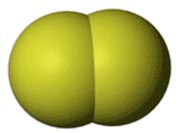 |
Microwave energy is absorbed, temperature
increases during expansion.
|
 |
Photons
Out
Temperature decreases, photon is
emmited during contraction |
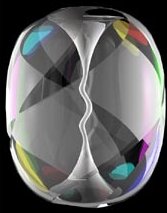 |
We have an Electric
Sun, a bit like a
Plasma International Light Bulb
absorbing microwaves, it absorbs energy
from the Universe, its time to remove
the blindfold so tightly tied upon your
head by Fusion Scientists, open your
eyes and your mind to the Plasma Age
and FFS learn about Tesla
(click here).
Please enjoy
these 4 short movies:
Sun
Movie - Energy Sink | Sun
Movie - Hotter Outside | Sun
Movie - Ye Old Fusion Model | Sun
Movie - Nuclear Blindfold
Technological
Plasmas Research:
It is estimated that 99% of
the visible Universe is in the plasma
state. Plasmas can be thought of as
a gas of positive ions (or atoms with
missing electrons) and free electrons.
This soup of electrical charges can
generate and interact with electric,
magnetic and gravitational forces producing
fantastic phenomena such as stars, solar
flares and supernovae. The remaining
1% is attributed to asteroids, comets
and planets where solids, liquids and
gases dominate. On earth the ionosphere,
the aurora borealis and aurora australis
(the northern and southern lights),
St Elmo's fire (a ghostly glow observed
at the top of ship masts) and lightning
are examples of naturally occurring
earth-bound plasmas.
Technological plasmas are quite different
from space plasmas. They have boundaries
(sheaths) that completely surround the
plasma. Their low fractional ionization
means the charged positive ions and
electrons are a small fraction of the
background neutral density. Technological
plasmas are almost never in thermal
equilibrium with the electrons much
hotter (typically 4x104 oC!) than the
ions and neutrals (approx. room temperature
at 23oC). It is these features that
make technological plasmas so useful
to industry. They can be found in every
household inside light bulbs, as candle
flames and on the streets in fluorescent
neon shop signs. Plasmas are also used
as display devices such as plasma TVs,
as thrusters for satellites, to sterilize
medical and bio-technological equipment,
to treat the toxic emission of environmentally
harmful gases and to recycle waste products.
By far the main application is material
processing where they are used to alter
the properties of materials such as
surface hardness, to deposit thin optical
films for filters, in the fabrication
of microchips and electronic components
found in every electronic device.
|

|
|
This page started
as interest in the use of nurturelites, particularly
T5HO type, becoming a popular alternative
to the outrageously expensive specialist
brand manufactured lamps, used in Terrariums,
Vivariums, Paludariums, Tropical and Marine
Aquariums. Rob met me when my baby boy
was under some blue LED grow lights, but
that's another phototherapy
story, he revealed his hobbies of snake
keeping and specialist plant growing and
the experiments began!
ROBS
THUMBNAIL PHOTOS HERE LINK TO:
Technical
and Aim: When all is said and
done, so much more is said than done.
So, there's no telling what will happen
next, but we start with analyzing the
PURple light looking for things that snakes
might like. The aim is to "Make Snakes
Happy", because happy snakes are healthy
snakes ...and that's about as technical
as we really want to get, but here goes:
Spectral Power Distribution of
nurturelite PURple
|
Spectral
Power
-
W/nm
per 1,000 lm |
|
| |
Light
Wavelength - nm |
Is all
UV light good for reptiles then? UVB.
the wavelength range that mainly contributes
to vitamin D3 photosynthesis (UVB-1, 280-304
nm) and (UVB-2, 305-319 nm) and UVA range
(320-399nm) contain another range that
may potentially destroy vitamin D3. this
range 290-310 nm is known as ”D-UV”. The
ability of a lamp to efficiently produce
vitamin D3 can be evaluated by comparing
values shown in undoctered SPD's. The
higher the irradiance of D-UV is in comparison
to other UV, the higher the probability
that D-UV radiation will start destroying
cutaneous vitamin D3.
Will my
reptile benefit from a PURple lamp?
We assume reptiles that need UV to photosynthesize
vitamin D3 should really be happy with
a nurturelite PURple lamp!
Do I need
Special Expensive Reptile lamps?
Further study seems to indicate strongly
that all snakes get all the D3 they need
from their food and do not need any UV
light at all. Fortunately our aim is to
make snakes happy so we haven't completely
wasted our time, because we know that
we have avoided nasty D-UV which is frequently
present in many so-called "Specialist
Reptile" lamps.
I thought
these lamps were made for plants? nurturelite
PURples were designed for emission of
Photosynthetically Useful Radiation (PUR)
and consequently the needs of plant life
were considered the most. Other lamp manufacturers
have made the effort to explain their
different point of view and opinion, not
ours, this can be looked at http://content.sylvania.com/app/display.aspx?id=003680211
Many hold the opinion that all UV light
is bad for plants, we have the a different
opinion, its that a little bit of something
naughty is sometimes nice!
UV light
is used and/or seen by Reptiles, Birds,
Insects and Plants
All humans can not see UV light. Most
humans are unaware of the world below
400nm, where our eyes can't see with out
the aid of technology.
| Krill
using their own built-in sunscreens,
or if you prefer, their high concentrations
of "mycosporine-like amino acids."
Algae and fungi can make their own
sunscreens in the form of mycosporine-like
amino acids (MAAs), which absorb
very well in the UV and are produced
in response to it. MAAs are very
common in marine species, especially
so in tropical coral reefs and the
Antarctic, two areas which are routinely
savaged by high UVB. |
 |
| Algae
are especially good producers of
MAAs, and it is from the algae that
krill can acquire their sunscreens,
although it seems that some sunscreens
are taken up more readily than others.
This means that krill can "piggy-back"
on algae’s natural response to high
UV: when UVB is at its highest,
the algae produce high concentrations
of sunscreen, the krill eat them,
and survive UV better than krill
low in MAAs. |
| |
| |
|
Pygoplites
diacanthus
A as seen by humans, B with UV filter.
The blue-white stripes (A) reflect
UV. |
|
Some prawns
(the mantis shrimps) have the world's
best colour vision, in some respects,
four times better than humans. These
lowly crustaceans also have complex
colour communication systems and
understanding how animals see their
own colours and those of the animals
around them is a major research
theme today |
| Germanodactylus
Soft Tissue Crest Close up
of a color UV photograph of the
crest and posterior part of the
skull on the part slab |
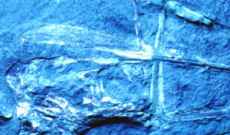
|
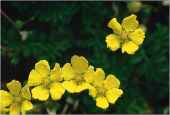 |
Flowers
photographed in normal daylight |
Same
flowers photographed using only
nrUV & UV light |
 |
| Dinosaurs
and Fish, the Birds & the Bees,
all common sense isn't it! Now those
that would have you believe all
UV is bad for plants might have
difficulty explaining this! |
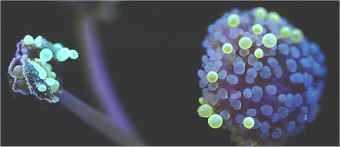 |
Landing
Lights for Hawk-Moths
Often cultivated and known by
its vernacular name "Four O'Clock",
has fragrant flowers pollinated
by hawk-moths and other nocturnal
pollinators. The UV markings of
the corolla are indistinct, but
a high degree of UV fluorescence
of the entire perianth and the
pollen is a noteworthy feature.
|
| Those
who only want to know about plants
first should skip to "UV for shorter plants with power
flowers" |
More on Plants & UV - flavour,
scent & colour
COMMERCIAL
APPLICATION - UV light slows foliar growth
and stem length. Bedding plants
are often grown from seedlings in greenhouses.
The growing conditions in a greenhouse
cause many plants to outstrip their containers,
growing too tall to be easily transported
by the time their color matures. Plants
overly tall for their containers may also
be aesthetically displeasing, which can
hinder their marketing. Height control
of greenhouse-grown plants has long been
an issue in the bedding plant industry.
Chemical growth regulators are often used
on ornamentals but are not considered
safe on vegetable crops. Using UV light
(particularly UVB) to regulate growth
is a relatively new, but much safer alternative
that works on several bedding plant species
as well as select vegetables, exposing
plants such as impatiens, tomatoes and
cucumbers to UV treatments for a few hours
slows their foliar growth and stem length
without reducing color or other favorable
characteristics.
Why do
plants need UV light?
UV increases the level of essential oils
in mints & the production of resin
by trichomes of relatives, UV is used
for maximum yield and quality of these
oils.
UV induces color development in flowers,
essential for beautiful red veins in green
Kale or Chard.
Full Power
Flower - UV light needed to fully fill
the glandular trichomes of basil.
Plants of Ocimum basilicum L. were grown
in the absence of UV light, both peltate
and capitate glandular trichomes were
incompletely developed in both mature
and developing leaves, the oil sacs being
wrinkled and only partially filled, there
was a large decrease in the number of
broken oil sacs among the peltate glands
as the mature glands broke open, releasing
volatiles. the number of glands and the
qualitative or quantitative composition
of the volatiles were badly affected by
the lack of UV light.
Tasty Sunscreen?.With
added UV light, an increased level of
essential oils yields a more powerful
scent and flavour. The essential oils
also aid in the absorption of UV light
, thus a sunscreen for plants. Plants
in the wild produce their own kind of
“sunscreen,” called flavonoids. Flavonoids
screen out some of the more dangerous
UVB-type radiation.
OK, what
are these Flavonoids? Flavonoids
are antioxidants in fruits, vegetables,
tea, and wine - plant nutrients that belong
to the polyphenol family. They are really
good for you. Flavonoids are responsible
for brilliant blues, purples, and greens,
as well as yellows, oranges, and reds
which cannot be attributed to carotenoids
(found in carrots). Carotenoids are fat-soluble,
while flavonoids are predominantly water-soluble.
Flavonoids are found in more concentrated
forms in beans and berries, but also red
wine, green tea, and soy products, as
well as many common fruits and vegetables.
Products are have been developed using
these molecules to battle cell and DNA
damage involved in cancer, heart disease,
diabetes and possibly brain degeneration,
by neutralizing"free radicals". Research
links them to reduced risks for cancer,
heart disease, and other age-related degenerative
diseases, as well as antioxidant protection
of body fluids such as blood. They also
may help prevent stroke, flu, tooth decay,
and other ailments. Apple skins rich in
flavonoids are discarded in all food products
such as juices because the flavonoids
in the skin cause cloudiness in the juice.
A waste, when you consider the antioxidant
activity in apple peel is potent enough
to stop cancer cells growing. Flavonoid
content is highest in the leaves of St.
John's wort (you must know about this
flower), and is at maximum concentration
during full bloom. In the flowers, the
content of flavonoids is highest at the
start of flowering, falling during flowering.
In tests, St. John's wort (flowers) had
the highest content of flavonoids (11.71%)
of any of 223 species tested.
Several hundred
flavonoids can be found in plants, they
are the compounds which affect colour,
aroma and flavour.
Colour
of plants - where's that pigment from?
| Pigment
Class |
Compound
Type |
Colors |
| Porphyrin |
chlorophyll |
green |
| Carotenoid |
carotene
and lycopene xanthophyll |
yellow,
orange, red yellow |
| Flavonoid |
flavone |
yellow |
| |
flavonol
|
yellow |
| |
anthocyanin
|
red, blue,
purple, magenta |
Colour depends on if your Sunscreen
is sweet and on Acid? (not forgetting
hydroxycinnamate) Anthocyanin
production requires light for photosynthesis
in the PAR range. Anthocyanins, such as
cyanidin, provide a natural sunscreen
for plants. Because the molecular structure
of an anthocyanin includes a sugar, production
of this class of pigments is dependent
on the availability of carbohydrates within
a plant. Anthocyanin color changes with
pH, which is why soil acidity affects
leaf color.
Arctic
research reveals new and unexpected effect
of ozone depletion
| Research
in northern Sweden revealed very
striking impacts of enhanced UV-B
on the nutrient budgets and microbial
populations below ground.
|
| |
A team of scientists, including
Dr Dylan Gwynn-Jones (IBS), studying the
effect of increased UV-B radiation (as
a result of the ozone hole above the North
Pole) on sub-arctic plants have discovered
that microbes living below ground are
significantly affected, even though they
are not exposed directly to sunlight themselves.
The team, whose findings were published
in Nature, believe that this completely
changes our viewpoint about the impacts
of ozone depletion in terrestrial ecosystems.
Bats
Scan The Rainforest With UV-Eyes
Source:
ScienceDaily.com October 17, 2003
Bats from Central and South American that
live on the nectar from flowers can see
ultraviolet light (Nature, 9. October
2003 p. 612-614). This was discovered
by York Winter, a German researcher at
Munich University and the Max-Planck-Research
Centre for Ornithology together with colleagues
from Germany and the University of Guatemala.
As bats generally lack cone pigments in
their eyes, the flower bats capture the
ultraviolet with the rhodopsin of their
rod pigments. This mechanism was unknown
in mammals until now. The researchers
discovered this ability while keeping
the bats in an environment with computer
controlled artificial flowers equipped
with small signal lights. Flower visiting
bats seem to need UV-vision, because the
flowers they visit in the rainforest are
characterised by a strong reflection of
UV-spectrum light at night. It remains
open whether the unusually high UV-sensitivity
found in these bats involves a further
photo-mechanism that is as yet unknown
for mammals.
Modern mammals
lost their ability to see ultraviolet
in the course of evolution, contrary to
birds and lower vertebrates. Of the originally
four cone pigments of ancestral vertebrates,
the higher mammals have retained only
two. Therefore, most mammals are dichromats
and have an only limited colour resolution.
Only the primates have regained a third
cone pigment by gene duplication and hence,
tri-chromatic vision with high colour
resolution. In night-active bats the reduction
of the visual system went even further:
they lost functional cones altogether
and retained only the rods as photoreceptors.
Rods are also present in the human retina
for black and white vision during low
levels of light intensity. The ability
for UV-vision in some other mammal species
is due to one cone pigment.
There is only little
light at night. But compared to daylight,
the colour spectrum is shifted towards
short, UV-wavelengths. The flowers that
are pollinated by bats in the central
and south American rainforest utilise
this fact by having their petals strongly
reflect UV radiation. But what does a
mammal do, if the need for UV-vision arises
again, but the necessary anatomical structure
has been lost? The flower-visiting bats
use their rod receptor for UV-perception
and catch the UV-photons with the so-called
beta-band of their photoreceptor, a peak
of minor sensitivity for light absorption.
In these mammals, therefore, only a single
photoreceptor is responsible for the perception
of light radiation over the whole wavelength
spectrum from about 310 nm to 600 nanometres.
Interestingly, bats achieve an absorption
efficiency in the UV bandwidth of nearly
50 percent of their photoreceptors major
peak of absorbance (alpha-band). This
is nearly five times the value expected
from in-vitro measurements of beta-band
absorption in rhodopsin molecules. Whether
this indicate a novel mechanism for light
perception in the bats eye that is still
unknown for mammals remains open.
The researchers
discovered that bats can see UV-light
in so called psychophysical experiments
that only involve behavioural observation.
The animals learnt over several months
in a computer-controlled artificial environment
that only flowers with a small signal
light will also give food. The researcher
made use of the bats ability to react
to the lit flowers by changing the wavelengths
of the signal lights and varying their
intensity. This showed that the bats could
still see the signal lights on the flowers
far into the UV range. All the same, bats
are colour blind. Attempts to teach them
colour discrimination remained unsuccessful.
|
|
|
|
|
|
 |



